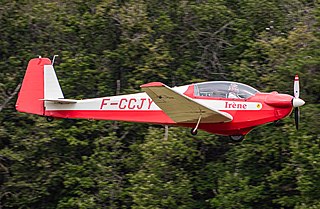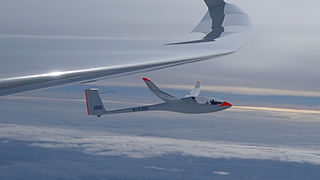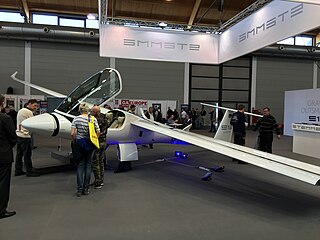Related Research Articles

The Schempp-Hirth Janus is a high performance two-seat glider that was built by Schempp-Hirth GmbH. It was the first high-performance two-seater.
The Preiss RHJ-7 is a side-by-side two-seat flapped glider developed by Preiss from a Schreder HP-14. The design used standard HP-14 wings with a 2 ft center section added to the fuselage, V-tail, fixed undercarriage and a single control stick between the seats. The RHJ-7 first flew in 1966 and was the starting point for the RHJ-8 and RHJ-9 variants, also homebuilts.
The Preiss RHJ-9 is an evolution of the RHJ-7 and RHJ-8 side-by-side two-seat flapped homebuilt gliders. The wingspan was increased to 18.29 m and the maximum mass was raised to 500 kg. A wing construction similar to that of the later HP-18 was adopted employing foam ribs bonded to the aluminum spars and skins. It first flew in 1978.

The Vickers-Slingsby T-65 Vega is a 15-metre class class glider which first flew on 3 June 1977. Of fibreglass construction, it features linked camber-changing flaps and airbrakes, and a retractable main and tailwheel.

The Glasflügel 206 Hornet is a Standard Class sailplane produced in Germany between 1975 and 1979. Of conventional sailplane design with a T-tail, it replaced the Standard Libelle, featuring composite construction throughout. Differences from the earlier aircraft included a redesigned canopy, retractable monowheel landing gear, and provision for 100 kg (220 lbs) of water ballast.

The ASH 31 is a single seat Open Class glider which can also be flown in the 18 metre class configuration.

The ASK 16 was designed by Rudolf Kaiser for production by Alexander Schleicher GmbH & Co of Furth, Germany. The aircraft is of welded tube, wood and fabric construction and has a low-set high-aspect-ratio wing.

The Stemme S6 is a two-seat touring motorglider manufactured by Stemme AG. Unlike the S10, the S6 has a non-retractable three-bladed propeller, a wider fuselage design, and tricycle landing gear, available both with fixed and retractable configurations. Its engine is a Bombardier-Rotax 914, the same engine used in the Stemme S10-VT. The designers placed great importance on noise and vibration reduction.
The PZL Bielsko SZD-52 is a Polish single-seat standard class sailplane produced by PZL Bielsko. It is a cantilever high-wing monoplane with a T-tail and has a retractable main landing gear and a fixed tailwheel. The wings have integral water ballast tanks.

The Scheibe SF 28 Tandem-Falke is a German motorglider that was designed by Egon Scheibe in 1970 and which flew for the first time in May the following year. It was a development of the Scheibe Falke with seating in tandem rather than side-by-side as in the original Falke design.
The Schreder HP-19 is an American, high-wing, T-tail, single seat glider designed by Richard Schreder.
The Schreder HP-22 was an American mid-wing, amphibious flying boat, cruciform tailed, two seat motor glider project that was designed by Richard Schreder. None were ever completed or flown.

The LAK-17 is a Lithuanian single-seat sailplane that was designed at the Lithuanian Aero Club, and is manufactured by Sportinė Aviacija.
The Rensselaer RP-3 is an American mid-wing, T-tailed single-seat, glider that was designed by Brian E. Thompson and produced by the Rensselaer Polytechnic Institute of Troy, New York. It first flew in 1998.
The ProFe D-10 Tukan is a Czech high-wing, strut-braced, T-tailed, two-seat motor glider that was designed and produced by ProFe and made available in kit form for amateur construction.
The LAK-19 is a Lithuanian single-seat Standard-class sailplane manufactured by Sportinė Aviacija.
The Aviastroitel AC-7M is a Russian mid-wing, T-tailed, two-seats in side-by-side configuration motor glider that was designed by Vladimir Egorovich Fedorov and produced by Aviastroitel, now Glider Air Craft.
The LAK-20 is a Lithuanian Open Class two-seat sailplane produced by Sportinė Aviacija.

The Stemme S12 is a German high-wing, two-seat motor glider produced by Stemme of Strausberg. It was introduced at AERO Friedrichshafen in April 2015, shortly after its first flight.

The Schleicher AS 34Me is a German glider manufactured by Alexander Schleicher. It is a self-launcher that uses an electrical propulsion system.